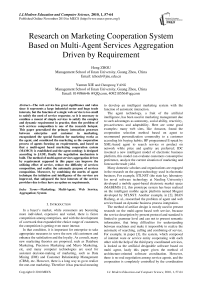Research on Marketing Cooperation System Based on Multi-Agent Services Aggregation Driven by Requirement
Автор: Hong ZHOU, Yanran XIE, Chengtong YANG
Журнал: International Journal of Modern Education and Computer Science (IJMECS) @ijmecs
Статья в выпуске: 1 vol.2, 2010 года.
Бесплатный доступ
The web service has great significance and value since it represents a large industrial sector and huge trade interests, but the function of a single web service is too small to satisfy the need of service requestor, so it is necessary to combine a mount of simple services to satisfy the complex and dynamic requirement in practice, then the problem of web services composition is one of the research hotspot. This paper generalized the primary interaction processes between enterprise and customer in marketing, encapsulated the special function for marketing works as the agent, and considered the marketing as the cooperation process of agents focusing on requirements, and based on that a multi-agent based marketing cooperation system (MAMCS) is established and the agent ontology is designed according to JADE, finally the negotiation mechanism is built. The method of multi-agent services aggregation driven by requirement supposed in this paper can improve the utilizing effect of service, reduce the difficulty of services composition, and realize the automatic purpose of services composition. Moreover, by combining the merits of agent technique the initiation and intelligence of the services are improved, that safeguard the best interests of the service providers due to they have an option on requirements.
Marketing, Multi-Agent, Web Service, Aggregation, System
Короткий адрес: https://sciup.org/15010051
IDR: 15010051
Текст научной статьи Research on Marketing Cooperation System Based on Multi-Agent Services Aggregation Driven by Requirement
Published Online November 2010 in MECS
In a buyer’s market, while consumers are becoming more individual, expensive and varied, there is fierce competition among enterprises, and with the development of a network that expanded the choice range of customers, the competition is getting even more intense.
In that condition, it is important for enterprise to take appropriate measures to serve the new old customers and enhance the satisfaction and the loyalty. As a result, many new marketing theories are proposed, such as Database Marketing, Precision Marketing and Micro Marketing, etc, and many computer technologies are used for assistant decision-making of marketing, such as Data Mining (DM) and Customer Relationship Management (CRM), etc. However, there is a long way to go to realize the one-one marketing. Therefore it has practical meaning to develop an intelligent marketing system with the function of automatic interaction.
The agent technology, a fruit of the artificial intelligence, has been used in marketing management due to such advantages as autonomy, social ability, reactivity, pro-activeness and adaptability. Here are some good examples: many web sites, like Amazon, found the cooperation selection method based on agent to recommend personalization commodity to a customer according his buying habits; HP programmed E-speak by XML-based agent to search service or product on network while price and quality are preferred; IDC invented a new intelligent model of electronic business platform, this model can evaluate customers consumptive preference, analyze the current situation of marketing and forecast the trade yield.
Many domestic scholars and organizations are engaged in the research on the agent technology used in electronic business. For example, STLNST (the state key laboratory for novel software technology at NanJing University) developed a mobile agent-based electronic market space (MABEMS) [1], this prototype system has been realized on the intelligent mobile agent platform named Mogent developed by STLNST. Another example, in [2], BIAN Haifeng, et al., researched the problem of agent and web service based on dynamic business process integration.
The method of artifact design is mostly used in present research on the multi-agent based web service, because the service description by present protocol and standard is limited to grammar level and can not to present semantic information, that bring difficulties for understanding between machines and make it impossible to realize the automatic of searching, calling and combining of service. For example, in paper [3], the system, which composed of internet ware or service entity cooperating with each other with the help of the third party coordinated services, is looked as the artificial designable software based on multi agent, lastly this paper given the method of architecture-oriented software coordination. However, there is no real negotiation among service agents, and the cooperation is completely controlled by the coordination
At present, there are fewer studies on web service composition based on active web service. To solve this problem, this paper generalized the primary interaction processes between enterprise and customer in marketing, encapsulated the special function for marketing works as the agent, and considered the marketing as the cooperation process of agents focusing on requirements. The method of multi-agent services aggregation driven by requirement can improve the utilizing effect of service, reduce difficulty of services composition, and realize the automatic purpose of services composition. Moreover, the initiation and intelligence of the service will be improved by combining the merits of agent technique, that safeguard the best interests of the service providers due to they have the option on requirements.
-
II. PRINCIPLE OF SYSTEM CONSTRUCTION
-
A. The model of service aggregation driven by requirement
Generally, customer will go through a five-stage decision-making process in purchase, including problem recognition, information search, alternative evaluation, purchase decision, and post-purchase behavior. In these five stages, the business association between enterprise and customer can be generalized as follow:
-
1) Requirements capturing and analyzing. In this stage, enterprise keep searching and capturing the customer requirements, and once a requirement is captured enterprise will analyze the purchase motivation by analyzing the historical data or communicating with customer.
-
2) Product recommendation. After understanding the requirements, enterprise will promote their products or services to customer in the proper way, which can not only make their products or services identified easily but also induce the purchase intentions of customer.
-
3) Price asking and consultation. With a purchase intention, customer will pay more attention to the price, thus a consultation will be made between customer and enterprise. This stage is the important and difficult point of marketing, since it decides whether a bargain can be made.
-
4) Transaction processing. Carrying out various activities to finish the whole transaction, generally include signing an agreement, payment, Choosing TPL Supplier and so on.
-
5) After-sale services. Offering prompt and reliable after-sale service to enhance the value, degree of satisfaction, profitability and loyalty of the customer, generally including goods tracing, installation and commissioning, changing or returning of faulty products, customers complains investigation and so on.
The technology of MAS supplies a good idea for marketing intelligence. A MAS (Multi-Agent System) is a system composed of multiple interacting intelligent agents. Multi-agent systems can manifest selforganization and complex behaviors even when the individual strategies of all their agents are simple. Multiagent systems can be used to solve problems which are difficult or impossible for an individual agent or monolithic system to solve [4].
By the technology of MAS, after the primary interaction processes between enterprise and customer in marketing are generalized as above, the special function for marketing works could be encapsulated as the agent, and thus the marketing can be regard as the cooperation process of agents focusing on requirements, as shown in
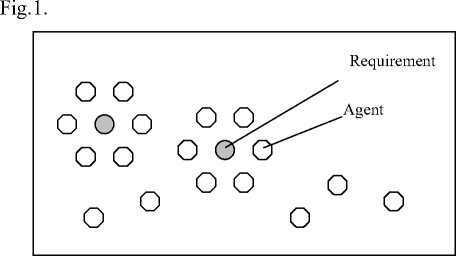
Figure1. The cooperation process of agents focusing on requirements
In this frame, services aren’t the passive entity but the self-governing automatic entity concentrating on user’s requirements actively. The frame not only embodies the ideal of “orient to men” but also helps to safeguard the best interests of the service providers due to have the option on the requirements.
-
B. The principle of service aggregating on requirement
In web environment, the requirement agent, who take up the mission of searching the requirement information, keep searching, describing and formatting the information of user’s requirements in the network, and the service agent with the function of providing special marketing service interact with the requirement agent to actively obtain the information of requirement information. Once the matching requirement is detected the service agent will send a request for registration to the requirement, and if there are more than one service agent can coordinate to satisfy a requirement they will aggregate on it.
The follow conditions must to be satisfied to ensure the services actively aggregating on the requirement.
-
1) To succeed in matchmaking between the service and the requirement. In terms of the mechanism of intention-behavior-action, one of the service’s behaviors can satisfy one of the requirement’s intentions, the matchmaking will be finished once all of the requirement’s intentions are satisfied by the service’s behaviors.
-
2) There must be a message exchange set throughout the aggregation process. This set contains the message for exchanging among different service behaviors and among different internal behaviors of a service.
-
3) There must be more than one automatic web service set for coordinating to satisfying requirement.
Aggregation Driven by Requirement
The set will be putted out by service matchmaking and exchanging message between service behaviors.
-
II. Framework of MBMCS
According above, the framework of MBMCS is established (as shown in Fig.2). The framework consists of three layers: user interface layer (UI layer), organization layer and resource layer.
|
User |
UI Layer |
|||
|
User Interface (UI) |
||||
|
User Interface Agent |
User Interface Agent |
|||
|
Organization Layer |
||||
|
Promotion Agent |
Promotion Agent |
|||
|
Consultation Agent |
Consultation Agent |
|||
|
Trade Agent |
Trade Agent |
|||
|
Service Agent |
Service Agent |
|||
|
Organization Agent |
Organization Agent |
|||
Resource Layer
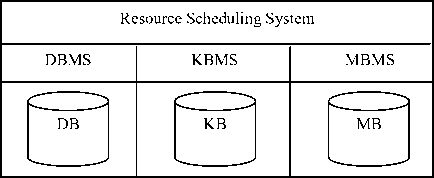
Figure 2. The framework of MBMCS
A. User interface layer
User interface layer is the top layer, and only one kind of agent, named User Interface agent (UIA), acting in here. UIAs keep intercepting online and communicating with user to capture requirement information. Once a requirement is confirmed, a business description file will be created and sent to organization layer by means of blackboard, and then various agents in organization layer will come together to meet the requirement. Besides that, UIA also feeds back the system operation information to user.
B. Organization layer
Organization layers, the second layer, is the main site of marketing activities carrying out, and five types of agent, while various agents of each type, are acting here. These agents keep watching the blackboard, and once there is a new requirement they will start analyzing the functional needs of marketing and compare with their ability. After evaluating self-ability, these competent agents will considerate accepting the task, and based on interact each other in communication language they will unite in a federation to meet the requirement.
Agents lie in organization layer are:
-
• Promotion agent (PA): the main function of a PA is to introduce product or service to customers and try to persuade them to buying.
-
• Consultation agent (CA): the main function of a CA is to consult with customers for the details of the deal in which the price asking is very important.
-
• Trade agent (TA): the main function of a TA is to complete the whole transaction once an agreement is reached.
-
• Service agent (SA): the main function of a SA is to offer after-sale service.
-
• Organization agent (OA): the main function of OA is to fetch the resource from resource layer to provide to the above agents according to their mission and to give assistance to these agents for cooperation.
In these five types of agent, the first four are generally called the marketing agents (MA) namely the service provider for marketing.
C. Resource layer
Resource layer is composed primarily of data base (DB), knowledge base (KB), model base (MB) and the resource scheduling system. It is responsible of providing resource support for various agents in marketing activities, the resource scheduling system can search and supply the resource in real-time as requested.
The most important thing of MBMCS is to ensure agents cooperation efficiently. The artificial coordination mechanism is mainly applied in present research on agent in business, e.g. [3].This mechanism needs to develop a grogram to control the cooperation process, which helps avoid uncertainty induced from free consultation, unfortunately to develop that control program is very difficult.
In order to realize marketing intelligence, in this paper, the mechanism of free consultation is applied. For this purpose, the agent function ontology is designed and the automated negotiation mechanism is put forward.
-
III. Design of Agent Ontology
Ontology is a description of the concepts and relationships that can exist for an agent or a community of agents [5-7]. All agents in this paper are designed based on JADE.
A. Structure of a JADE-based agent
JADE (Java Agent Development Framework) is a software framework to develop agent-based applications in compliance with the FIPA specifications for interoperable intelligent multi-agent systems. The goal is to simplify the development while ensuring standard compliance through a comprehensive set of system services and agents. JADE can be considered an agent middle-ware that implements an agent platform and a development framework. It deals with all those aspects that are not peculiar of the agent internals and that are independent of the applications, such as message transport, encoding and parsing, or agent life-cycle.
The main segments included in JADE platform:
-
1) Agent Management System (AMS): there is only one AMS existing in an agent for managing the agent platform. The principle functions of the AMS are responsible for creation, deleting and transferring of the agent, maintaining the agent’s named files and the relevant translation address, providing write pages for other agents, managing agent’s registration, deleting, logout and modification, controlling the life cycle of agent.
-
2) Directory Facilitator (DF): The DF is responsible for managing the foreign services of an agent. There is at least one DF in every agent platform, and several DF form a confederacy. The services provided by agent must be registered in DF, and DF also can provide the yellow pages service for each agent.
-
3) Agent Communication Channel (ACC): The ACC is responsible for providing communication channel for interaction between agents, AMS and agent services.
-
4) Agent Container (AC): The AC is the environment that agents live in, and an agent platform can possess several AC which can be distributed in several host computers. JADE agent will execute in one AC in which to share the services above with other agents, and the interaction between agents will be realized by agent communication language(ACL) made by FIPA.
The structure of a JADE-based agent is composed of five elements (Fig.3.):
-
• Capabilities: To store the function modules of an agent and each module is corresponding to a special capability.
-
• Agent Behaviors Scheduler: To arrange the behaviors of an agent in order of the task requirement.
-
• Agent Behaviors: To store the behaviors of an agent, these behaviors are created according to the intent and capability of the agent and are saved in behavior base.
-
• ACL Message Box: To communicate with other agents in ACL (agent communication language). ACL Message Box is composed of three parts, including the access mode for sending and receiving ACL message, the buffer for saving ACL message and the pattern matching for searching ACL message, and according to the searching method, ACL message is divided into
Capabilities

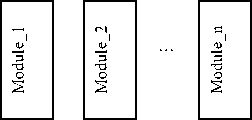
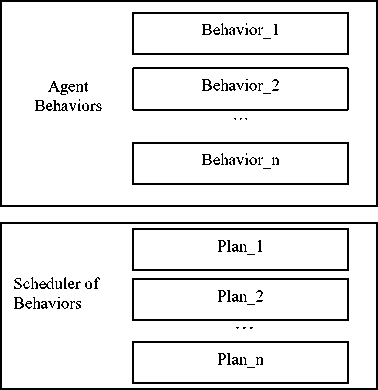
Message Box





Figure 3. The structure of a JADE based agent
three classes: timeout-based, blocking-based and polling-based.
-
• Life cycle Management: To manage the life cycle of an agent including initializing, activating, suspending, waiting, moving, and dying, etc.
All agents in MBMCS are established based on JADE and have the same structure but different in functions. The function modules of different types of agent will be discussed below.
B. The function module of UIA
A UIA is mainly engaged in three tasks. One is to communicate with customers for capturing requirements, another is to create a business description file and send it to organization layer by means of blackboard, and the third is to feed back the system operation information to user. Thus the function modules of a UIA are listed below.
-
• Communicating module: To intercept online to capture requirements and to validate requirements based on analyzing data and communicating with customers.
-
• File creating module: To normalize the validated requirements to form a business description file in BPEL (Business Process Execution Language) and publish it.
-
• Information feedback module: To feed back the system operation information to user in real time for supervising or manual adjusting.
C. The function module of MA
As the marketing executor, the function of a MA is mainly related to finish the marketing task, and in order to offer the adaptive service, a MA could be able to adjust its performance characteristics according to its environment. The function modules of a MA are listed below.
-
• Task searching and matching module: to search the marketing tasks and compare them with selfabilities, and once a matched task is taken a consultation among agents will begin. There are tow types of searching mode, one is the Web service searching based on ontology and WSIG (Web Services Interoperability Guidance), the other is the agent service searching based on local service registry base.
-
• Communication control module: to communicate with OA, UIA and other MAs, for example, to consult with other MAs for forming a union.
-
• Executive module: to work with other MAs in a union and offer a special marketing service to meet requirements.
-
• Adaptive module: to monitor the transaction and, according to its environment, adjust its performance characteristics in time to improve the quality of service.
D. The function module of OA
OA is responsible for providing for MA with resources according to its mission requirement, these resources are fetched from the resource layer after OA interact with the resource layer, and OA is also responsible for giving assistance to MA for cooperation. The function modules of OA are listed below.
-
• Bid inviting module: To make a notice call for bid according to requirement. MAs will join the tender after evaluating capability by self and consulting with each other. This module is also responsible for evaluating the cooperation efficiency of MAs and adjusting the cooperative relationship of them if necessary.
-
• Operation monitoring module: To monitor and adjust the operation of the union of agent to ensure it operating smoothly and adapting itself to any complex environment. In addition, this module is also responsible of receiving the operating result and feeding it back.
-
• Resources support module: To meet the resource needs of MA by interacting with the organization layer for searching and fetching the appropriate resource.
-
IV. Negotiation mechanism
As mentioned above, there is more than one MA acting focusing on requirements in the organization layer of MBMCS, and every MA wants to do more for greatest reward, thus the competition will take place among MAs. However, a single MA is not able to meet the requirements completely, so they must work together to get more powerful capability.
To meet the requirements better, the service quality of MAs will be evaluated, and the MA with high score will be selected to form a union. However, different MAs could have the same functions, and there is a little difference among the same functions in different MAs in capability, then the competition among MAs will still be here though a union has been formed, so it is important to distribute the service sub-functions of the needs to the MA in a union fairly. The solution is to build a multiagent negotiation frame, in which the service requestor can consulting with the MAs in limited times, and a cooperation agreement will be established until the expected value of the service requestor and the MAs are met and the total benefit of theirs is maximized.
A. Evaluation of Service quality of Agent
-
1) Service quality standard of the QoS-based agent
In this paper, the ontology of QoS [8] is used to evaluate the service quality of the MA, and the main measure indexes included in QoS are listed as follow:
-
• Availability: The responsiveness of the service provider to the service requestor, including TTR (mean time to repair) and Up Time.
-
• Reliability: Reliability of service, including Fault Rate and MTBF (mean time between failures), etc.
-
• Capacity: The maximum number of service can be handled.
-
• Economic: Economic aspect related to service, such as Usage Cost.
-
• Interoperability: The dependency on standard of service, such as WSDL (web services description language).
-
• Performance: The system performance criteria, such as Throughput and Response Time, etc.
-
• Robustness: Capability of handling the incorrect or abnormal input.
-
• Scalability: Standing for that whether the capacity of service can be expanded as required.
-
• Security: Description of different types of service and security level.
The ontology of QoS supplies a uniform standard for evaluating the service quality of an agent. For a given service agent, once it completes a special function the relevant value in the QoS ontology will be measured and recorded to judge of the agent’s service quality.
-
2) Data processing
In this paper, the method of multiple attribute decision making (MADM) is used to evaluate agent’s service quality, and the calculation procedure and method are listed follow.
• Normalizing data.
According above, the different quality standards in QoS have different dimensions, so the method of range transformation is used to do the non-dimensional indicators of treatment.
Assume there are x service entities Agent 1 , Agent 2 ,…, Agent n providing certain service in same time, the QoS value of x th entity respectively is Ai , Ri , Ci , Ei , Ii , Pi ,
ROi , Si and SEi , then all QoS value of n entities
construct a n X9 matrix Q = ( Q ij ) n x 9 ,here Q ij stands for
the value of the i th quality standard of the i th entity.
To the cost index, such as economic, the formula could be used.
follow
Qi max
Q ij
Yj =\ Q m ax
Q m j in
, if Q m j ax
- Q ™n * 0
[ 1, else
To the benefit index, such as formula could be used.
scalability, the
follow
Q Q^
Y =j Q j ax
1 1, else
Q m j in
, if Q m j ax
- Q ™n * 0
here ,
Q^ = Max ( Q j ),1 < i < n ;
Q ' = Min ( Q j ),1 < i < n
Through conversion above, the decision matrix
Q = ( Q ij ) n x 9 will be converted to a standard
matrix Y = Y ) n x 9, here 0 < Y j < 1, and the benefit index and cost index both are converted to the benefit index whose the largest and smallest values are 1 and 0 respectively.
• Determining the weight of quality standard.
The important degree of the service quality standard will be varied for different users, so the weight values of the service quality standard must be given according to the need. In this paper, the method of Delphi is used to determine the weight of the service quality standard.
3 ) Evaluation of comprehensive value of the agent service quality
Assume the standardized matrix is Y = ( Y )„v0 then the IJ n X 9
Qos comprehensive value of the i th agent Q i can be worked out by formula follow:
n
Q i = £ to Y j , j G (1,2, l ,9) (3)
i = 1
Here, ® i is the preference weight of the service
n
requestor to service quality, ^ to i = 1.
i = 1
According to these methods, the service quality of a MA can be worked out, and the MA who gets the highest score will have the priority to be a member of a union, thus a preliminary cooperation will be formed.
B. The algorithm on web services matchmaking based on QoS
The general service matchmaking algorithm can only support matchmaking judgment in form of function, so if there is more than one entity satisfying the service request then one will be selected randomly from which as the result returned. It is known that the Qos value of an entity often is obtained from its historical data, if the Qos value of the service providing entity could be saved in the database of an intermediate entity (QoSDB) after it has completed a certain service, then this information can be used to solve the problem of service matchmaking.
The main idea of the algorithm on web services matchmaking based on QoS:
-
• The intermediate entity work out the set, made up of the service provider satisfying the service request, by the general service matchmaking algorithm, this set is called candidate result set(CResult);
-
• If CResult is the null set or only one entity in it then stop calculation;
-
• Evaluating the QoS values of entity in CResult;
-
• Selecting the entity whose QoS value is the largest as the returned result. If there are several entities with same QoS value then randomly pick one out as the returned result.
The formal description of the algorithm is given below: Step1. Assigning null to variables of Record, Matrix and SMatrix;
Step2. Working out the set CResult, made up of the service provider satisfying the service request, by the general service matchmaking algorithm;
Step3. If CResult is null set then returning null set, exit;
Step4. If only one agent in CResult then returning this agent, exit;
Step5. If CResult includes k entity, then CResult=( Agent 1 , Agent 2 ,… Agentk );
Step6. Selecting one entity Agenti from CResult randomly and reversing CRsult = CRsult - { Agent i } ;
Step7. Taking the set HisQoSi that consists of all historical data of the QoS values of Agenti from QoSDB;
Step8. If HisQoSi is a null set then Initializing the QoS quality standard of Agenti , else calculating the mean value of the quality standard in HisQoSi . Saving the quality value of Agenti inRe cord , then Re cord = ( Ai , R i , C i , E i , I i , P i , RO i , S i , SE i );
Step9. If CResult isn’t a null set then going to step 6;
Step10. Evaluating comprehensive value of these k agents Q 1, Q 2, K , Qk ;
-
Step11. Returning the agent, which correspond to the maximum of Q 1, Q 2, K , Qk .
C. The negotiation framework Multi-Agent based
As mentioned before , a MA will accept the mission only when it gains the benefit more than the minimum expected value, however it is difficult to satisfy all MA. At the same time, a MA would like to do more to maximize the rewards, and then a conflict will occur among MAs when a marketing task could be completed by more than one MA. In a word, the final proposals couldn’t be obtained till the expected values of the service requestor and the MAs are met and the total benefit of theirs is maximized.
According above, a ne go tiate framework is built as shown in Fig.4, where Q stands for the minimum expected benefit of the service requestor. The stages of consultation are as follows.
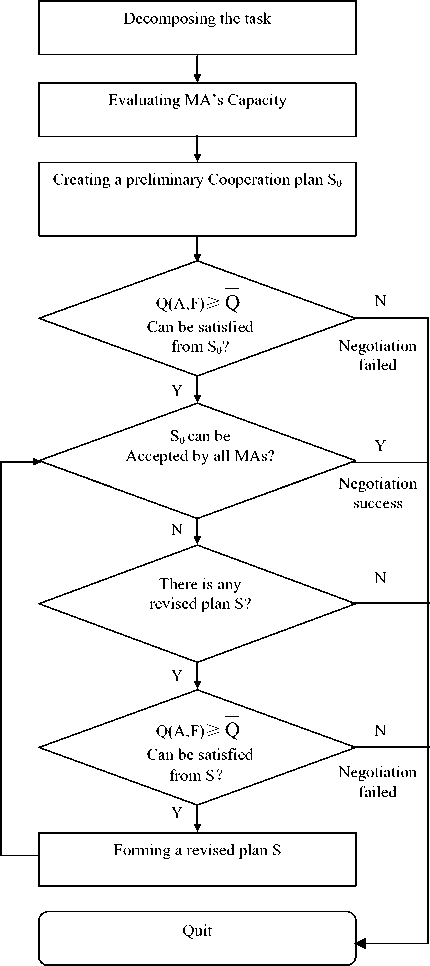
Figure 4. The negotiation framework
Step1. Firstly, the service requestor will divide the requirement into some tasks. Secondly, it will evaluate the service quality of MAs according to the task needs, after that these MA who get the highest score will be choose to form a union, thus a preliminary cooperation plan will be formed. Finally, through these steps above, if there is a cooperation plan comes out, that means the consultation succeed, then go to next step else quit.
Step2. The MA will evaluate the benefit from the current cooperation plan, it will accept this plan if it brings more benefit than the minimum expected benefit. If all MA accept the current cooperation plan then consultation succeed and quit else go to next step.
Step3. The MA, who refuses the preliminary cooperation plan, will revise the plan and put forward a new operation plan. In this step, if a new plan can be putted forward then go to next step else quit.
Step4. The service requestor will select the one whose service quality evaluation is highest from the revised plans. If the service quality evaluation of the selected plan is beyond the minimum expected benefit of the service requestor then go to step 2 else quit.
-
V. Conclusion
In order to realize marketing intelligence, based on analyzing of the interactive process between enterprise and customers in marketing, the main interactive process are generalized and encapsulated as the agent, thus the marketing campaigns is regard as the cooperate process of agents focusing on requirements.
In the marketing campaigns, the service requestor always wants to be served better, on the other hand, there are more than one agents can meet a given requirement since some of them could have same functions, so these agents will compete with each other. Therefore it is important to build a proper cooperation mechanism to maximize agent’s advantages and achieve total optimum profits. For this reason, the function ontology of agent and the automatic cooperation mechanism are built in this paper.
The function ontology is the foundation for describing the agent capabilities and the requirement functions, it helps agent to discover and understand the requirements. The automatic cooperation mechanism can supply various cooperation plans for different requirements. In this paper, a multi-agent-based negotiation framework is built as automatic cooperation mechanism. In this framework, the service requestor can consult with the service provider agents in limited times to reach an agreement, which can satisfy the minimum expected value of the service requestor and the service provider agents and maximize the total benefit of them.
The future researches mainly include those how to build the union quality evaluation model better suited to service and how to forecast and control the multiple result of consultation.
Aggregation Driven by Requirement
Список литературы Research on Marketing Cooperation System Based on Multi-Agent Services Aggregation Driven by Requirement
- Xu Feng; Lü Jian; Tao Xianping; Guo Reijing; Su Min; Chen Hongqiang. MABEMS-A Mobile Agent Based Electronic Market Space [J]. Journal of Naijing University (Natural Sciences), 2002(02), 38(2):132-138(in Chinese).
- BIAN Haifeng; XU Junhua; LIU Zuzhao. Agent and webservice based on dynamic business process integration (in Chinese) [J]. Journal of Tsinghua University (Science and Technology), 2003,3: 49-54.
- Lii Jian, Tao Xianping, Ma Xiaoxing, et al. On Agent-Basel Sofware Model for Internetware. Science in China Series E; Information Sciences, 2005,35(12):1233-1253(in Chinese)
- Davis R and Smith R G. Negotiation as a metaphor for distributed problem solving. Artificial Intelligence.1983,20:63-109.
- R. Neches, R. Fikes, T. Finin, T. R. Gruber, R. Patil, T. Senator, and W. R. Swartout, Enabling technology for knowledge sharing, AI Magazine, American Association for Artificial Intelligence, Menlo Park,CA,1991, 12(3): 36-56.
- T.R. Gruber. A translation approach to portable ontology specifications. Knowledge Acquisition, Academic Press Ltd., London, 1993, 5(2): 199-220.
- W. N. Borst . Construction of Engineering Ontology for Knowledge Sharing and Reuse. PhD thesis, University of Twente, Enschede,1997.
- Menasee D. A, Ruan H., Gomaa H. A Framework for Qos-Aware Software Components. ACM SIGSOFT software Engineering Notes. 2004, 29(1):186-196.
- SYCARA K,etal. Automated Discovery, Interaction and Composition of Semantic Web Services [J]. J. Web Semantics, 2003, 1(1):27-46.
- Sycara K, Widoff S, Klusch M et al. LARKS: dynamic match-making among heterogonous software agents in cyberspace [J]. Autonomous Agents and Multi-Agent Systems, 2002, 5(2):173-203.
- M. P. Singh, M. N. Huhns. Service-Oriented Computing Semantic, Processes, Agents. John Wiley & Sons, Ltd, 2005
- M. P. Papazoglou, D. Georgakopoulos. Special issue on service-oriented computing. Communication of ACM. 46(10): 24-28, 2004
- B. Benatallah, Q. Sheng, M. Dumas. The self-serv environment for web services composition. IEEE Internet Computing. 7(1):40-48, January/February 2003
- R. Khalaf, N. Mukhi, and S. Weerawarana. Service-oriented composition in BPEL4WS. In: Proceedings of the 2003 world wide web conference. IEEE Computer society, 2003
- L. Zeng, B. Benatallah, A. Ngu, M. Dumas, J. Kalagnanam, and H. Chang. QoS-aware middleware for Web Services Composition. IEEE Transactions on Software Engineering, vol. 30, pp. 311-327, 2004.

